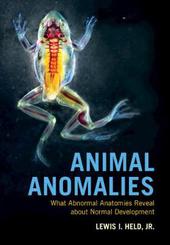
|
Animal Anomalies: What Abnormal Anatomies Reveal about Normal Development
Paperback / softback
Main Details
| Title |
Animal Anomalies: What Abnormal Anatomies Reveal about Normal Development
|
| Authors and Contributors |
By (author) Lewis I. Held, Jr
|
| Physical Properties |
| Format:Paperback / softback | | Pages:294 | | Dimensions(mm): Height 242,Width 170 |
|
| Category/Genre | Molecular biology
Cellular biology (cytology)
Zoology and animal sciences |
|---|
| ISBN/Barcode |
9781108819749
|
| Classifications | Dewey:571.9761 |
|---|
| Audience | | Tertiary Education (US: College) | | Professional & Vocational | |
|---|
| Illustrations |
Worked examples or Exercises
|
|
Publishing Details |
| Publisher |
Cambridge University Press
|
| Imprint |
Cambridge University Press
|
| Publication Date |
18 March 2021 |
| Publication Country |
United Kingdom
|
Description
Among the offspring of humans and other animals are occasional individuals that are malformed in whole or in part. The most grossly abnormal of these have been referred to from ancient times as monsters, because their birth was thought to foretell doom; the less severely affected are usually known as anomalies. This volume digs deeply into the cellular and molecular processes of embryonic development that go awry in such exceptional situations. It focuses on the physical mechanisms of how genes instruct cells to build anatomy, as well as the underlying forces of evolution that shaped these mechanisms over eons of geologic time. The narrative is framed in a historical perspective that should help students trying to make sense of these complex subjects. Each chapter is written in the style of a Sherlock Holmes story, starting with the clues and ending with a solution to the mystery.
Author Biography
Lewis I. Held, Jr. is Associate Professor of Developmental Genetics in the Department of Biological Sciences at Texas Tech University. He is a fly geneticist who has taught human embryology for 35 years. He studied molecular biology at the Massachusetts Institute of Technology (BS, 1973), investigated bristle patterning under John Gerhart at the University of California, Berkeley (Ph.D., 1977), and conducted postdoctoral research with Peter Bryant and Howard Schneiderman at the University of California, Irvine (1977-86). This is his sixth scholarly monograph, following Models for Embryonic Periodicity (Karger, 1992), Imaginal Discs (Cambridge, 2002), Quirks of Human Anatomy (Cambridge, 2009), How the Snake Lost its Legs (Cambridge, 2014), and Deep Homology? (Cambridge, 2017).
Reviews'With rigorous arguments presented in captivating prose and crystal-clear drawings so rich in information, this new masterpiece by Lewis Held is a unique introduction to the genetics of development. Here, monstrous and normal illuminate each other, as products of the same developmental logic. This book is full of inspiring insights, on a par with the works of the great developmental biologists highlighted in its pages.' Alessandro Minelli, University of Padova, Italy, and author of Understanding Development 'Orthodoxy is so rife in science these days it is strangling originality. The spread of 'best practice' as well as the related belief that there is only one ideal way to understand and explain things has stifled both diversity and imagination. ... Lewis Held shows us there is another way - to look at the natural world open-mouthed and open-minded. We are taken on a lively ramble through myriad natural phenomena in countless species and the attempts of scientists to understand them. There is an infectious sense of the wonder and complexity of everything. There are innumerable nuggets to be found and it is fun. ... His book sings like the descant in a choral rendition of a familiar hymn. I recommend it, but don't try and read it all in one go!' Peter A. Lawrence, University of Cambridge, UK 'In this wonderful exploration of development, Lewis Held uses both familiar and less-well-known examples of frogs, flies, dogs, and cats to delve deeply into the underlying biological principles their traits can illustrate ... Held also describes the genetic basis of traits that pet-owners find endearing ... In addition to this fascinating exploration of genetic mechanisms and their outcomes is another idea that I have always valued in Lewis Held's work: the respect for pioneering insights and discoveries by earlier researchers like Curt Stern, Walter Gehring, Ernst Hadorn, and others. I remember hearing a faculty advisor once criticize a new graduate student for planning to cite a research article that was more than a couple years old as being irrelevant to 'modern research'. Thankfully, writers like Held remind us that the story of discovery is a long one, and critical insights can come from anywhere.' Jim Thompson, Drosophila Information Service 'Recommended. Graduate students and faculty.' D. A. Brass, Choice
|